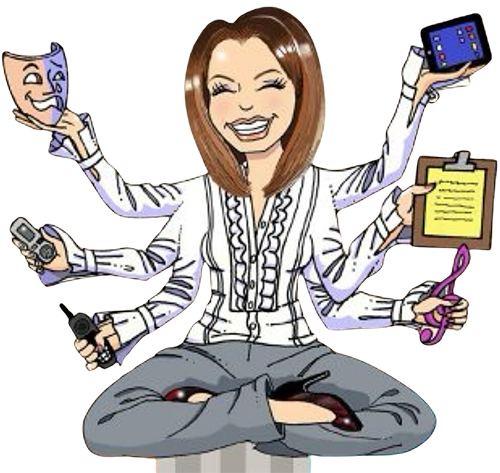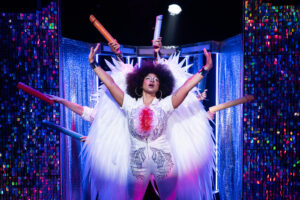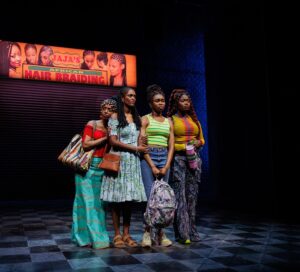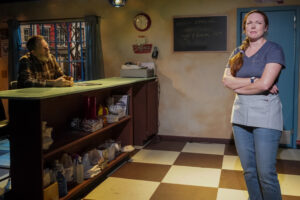Museum-goers will enjoy 175 works that include paintings, sculptures, objects, photographs, and short films.
These women have a
dialogue with the public, they express the independence that they could not
find in Europe
Yes, for example, Andre Breton’s own wife Jaqueline Lamba while she did some collages and some work before
they moved to the US during the war, she started these wonderful paintings
during the war in New York City and also when her divorced started. She spread
out her own wings doing a lot of artwork most of which unfortunately was lost,
a few things from New York are left and most of them are in the exhibition.
She ventured out with an American surrealist sculptor and worked with him on a
few things, joined efforts. I am not so sure she would have developed without
coming to New York City.
 |
and became friends with Frida Khalo.
Leonora Carrington was already working in Europe but seemed
to really blossom more when she settled in Mexico City. She was in Europe
involved with Max Ernst and while she did marry a photographer in Mexico city
–another exile- Mexico offered her somewhat of isolation but also freedom.
She did not have to follow what were the dominant trends at the time, off
course it did not interest her much at all, not until the end of her career.
but from the European dominant environment, she could then explore her own
interests and ideas in art-making, witchcraft, and esoteric religions. I am not
so sure she would have had that strength to do it in Europe. In Europe once Max
Ernst left her, he was forced to a prison camp by the fascists, she fell apart.
So those kinds of things. And the women who just grew up here had this feeling
of liberation and independence.
Do you think this ‘lack
of independence’ was a matter of gender?
they were and still are a number of women running galleries, the men ran most
of them and, they where the ones
promoting surrealism in the East Coast, not so much on the West Coast. In San
Francisco one of the leading promoters was a woman, Director of SFMOMA at the
time, she brought a lot of surrealism to the city. But most of the dealers of
surrealism in the US were men. Back East a number of the dealers and directors
of museums all went to the same school, the Fogg art museum at Harvard had a
program, and all the students from it, raised in the early years where male.
Not always.
they where and where they were exhibiting they might have kept them a little longer to
get into exhibitions or have their solo exhibitions, but most of them did and I
know that in Mexico city they were well received. In the United States well,
our country has a lot more art centers than Mexico. Many of these women were part of the official
surrealist circle, they weren’t official themselves in that they did not sign
the manifestos although a lot of their men husbands did not sign them
either.
 |
| ‘Selpf portrait’-Helen Lundeberg |
muses- Some of them where taken seriously and some of them were not. It
depends. Some of them were ignored or not encouraged, but some of the men did
encourage the women. In LA Lorser Feitelson encouraged Helen Lundeberg who was
a very shy and retiring person all her
life. He pushed her into the forefront and promoted her, as opposed to him and they both established post-surrealism. Whereas Austrian painter Wolfgang Paalen came to Mexico with
the French poet Alice Rahon, and he encouraged her to paint. In Mexico, she was
one of the few abstract surrealists. So they did encourage them, and then
others who just ignored their wives’ creativity or just took it as second place
to their own creativity.
is an installation with ropes…
exhibition design, I said it would be too boring and I wanted something
surrealist. Surrealists did their own installations that got crazier and
crazier as time went on; in the US in the mid-forties, there were two
surrealist oriented exhibitions with strings, string installations, the most
famous one being by Marcell Duchamp “First Papers of Surrealism” was the title
of the exhibition, the first papers referred to the immigration paperwork that
the exiles needed to get to the US. He strung string all over the ceiling and in
front of the paintings so it would look
sort of like a spider web and you could barely get thru it.
 |
| “First Papers of Surrealism” installation by Marcell Duchamp |
Friedrich Kiesler the Austrian surrealist, was primarily
an architect, he did strings around the same time for one of Peggy Guggenheim’s
commercial galleries, “Art of this century” also in New York City. His was not
as chaotic. So I asked our designer to think about those and others I gave her
a book on it, and she went on the web too; Came back, and I discussed the
surrealists with her, especially the women who had difficult careers and broken
spirits, some of them had mental problems as a result of them, or just had
them. Some of them also committed suicide and some of the paintings are about
those emotional problems.
space; diagonal walls with middles so we
cut down these large galleries into smaller more fluid galleries and
suggested we do some more entangled rope, a high op which I liked the idea and
everybody else did, where not sure if it was going to work but it seems to have
worked really well; it also helps to slow traffic directionally but it suggests
what Marcel Duchamp and Kiesler wanted and it is especially telling and very related
to the show in the sense of the influence, native American cultures and
landscapes. There are some wire
sculptures by Alice Rahon, the wire suggests the rope, the string aspect.
 |
| wire sculpture by Alice Rahon |
There
is also a cradle film by Maya Deren the filmmaker, cradle is a string game,
kids play it in the US I do not know if they play it in Mexico. It turns out to
be a great popular game and source of magic used throughout various tribal
cultures; in the film, the string is going up and down the neck, head, and back
of Marcel Duchamp and then it shows the kids playing the game and that connects
with the rope and people like it a lot.
symbolic of the broken lives of these
women and I liked the idea so I promoted that and the colors of the walls are
dark grey, slightly harmonious but I did not want beautiful harmonious colors
because
walls and the rope are also about disruption.
visually it is an attractive installation and it works well, it is not
uncomfortable like the real surrealist installations. One of the, I think it was
Dalí’s where they had a flower hanging on the roof over the table where the
dinner party was happening. Ours is somewhat tamed in comparison but it is
unusual.
only have two films by Maya Deren, I
was hoping to find more women surrealists filmmakers but, we couldn’t. The
exhibit begins with a Maya Deren film, probably the most surreal called “Meshes of the Afternoon” it is definitely her
most famous, we have it blown up large over the doorway entrance. It is classic
surreal imagery, emphasis on what is reality, what is a dream, what is not real.
Ambiguity shadows it is black and white of course, done in the early forties;
plus, there are images that look like Buñuel and Dali paintings and it was also
filmed only a few miles from the LA County museum in the Hollywood hills where
Maya Deren lived at that time, so it has got this local connection which
everybody seems to love.
There is the introduction that discusses the main themes, what the women explored. Tere Arcq my co-curator writes about the women in Mexico amongst the women in the US, the rest is thematic based there is one on native American cultures, landscapes. There is another that is about women who are interested in esoteric philosophies, religions, witchcraft, alchemy that one is called ‘Down the rabbit hole’ by early feminist writer Gloria Feman Orenstein who teaches here in Los Angeles and that is one of her main interests; there is Salomon Grimbergs essay he is a child psychologist, he wrote on several major artists, the better-known ones, he did a psychological/psychiatric interpretation of their work. There is one on just the photographs and how surrealist photography fits into avant-garde photography in Europe and North America and the last one is relating contemporary feminist women artists who were influenced by surrealism, it is a short essay but really really good. There are three different editions of this book, one in English, one in Spanish and one in French.
come about?
and became more interested in US surrealism in graduate school in the early
80’s. I have been wanting to do this show since the ’90s but surrealism was
very out of fashion, and women artists were beginning to become more important
but I got sort of turned down and, about seven years ago we sent our American
art collection to Munal (Museo Nacional de Arte) in Mexico city and Tere Arcq
who was at the reception was attracted to the beautiful paintings, she came up
to me and started asking me about women surrealists in the United States, we
swapped business cards and started emailing. She was interested in women
surrealists in Mexico and I was working in US ones and been wanting to do a
show for years, we started talking and that is how it came about, it has been
5 or 6 years, big shows take a long time.
Even I am amazed at the result, the book is selling like
hotcakes, they already went to a second printing for the English language which
is unheard of, the book has not even been reviewed yet. Even on weekdays, the show is crowded, people of all ages. It is a very large exhibit, it will be
smaller in Quebec and in Mexico City;
telling us this, that people have been reading more and commenting to each
other, we normally do not see that.
Most of the women are unknown, except for
Frida Khalo and Remedios Varo, but fewer people here do not know Remedios Varo.
But they are spending a lot of time in
the exhibition and looking a lot more. Amazingly, they are spending an hour
and a half, two hours here.
 |
| Remedios Varo |
I think she was if not one the most imaginative of the women surrealists, she was definitely the
most technically astounding,
 |
| Remedios Varo-Papilla Estelar (Celestial Pablum) |
 |
| Remedios Varo ‘La Huída (The Escape) |
 |
| Remedios Varo. Creacion de las aves |
she was just wonderful and we have great examples.
 |
| Remedios Varo-Armonía |
 |
| Remedios Varo-Mujer saliendo del psicoanalista |
‘In Wonderland’ is now showing at LACMA until May 6th.





















